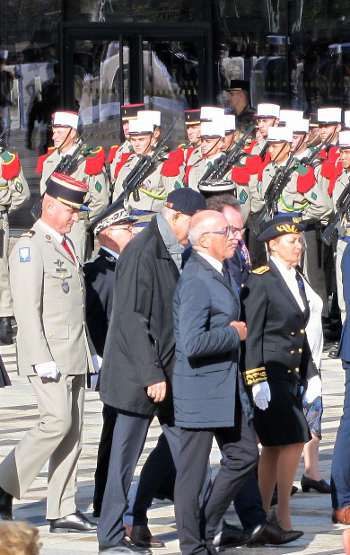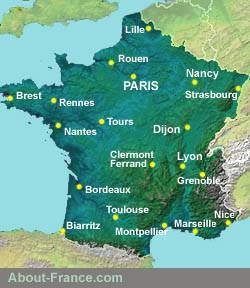- Explore
France ►
- Essential
pages
- Travel in France
- Where to go
-
What to see and do
About-France.com
- the connoisseur's guide to France
La
Grande Guerre -
1914-1918
Map of
World
War 1 principal sites in France : battlefield sites,
cemeteries, monuments and other location.
Red
markers : British and Commonwealth military cemetries
Blue
markers : French military cemeteries and monuments
Pink
markers : United States war cemeteries
Mauve
markers : international war cemeteries
Grey
markers : large German war cemeteries
Green
markers : Other historic locations, war museums and places
to visit.
Click markers for details : zoom and pan map for larger scale.
Today, the only sounds that disturb the fields and forests of much of
northeast France are those of farm machinery and passing road traffic,
or in more bucolic locations, birdsong, the bells of grazing cattle
and other traditional rural sounds.
If you were
to stand - for example - in the depth of the countryside, just a
kilometre east of the church of the small village of Romagne
sous
Montfaucon, in the Meuse department, you could feel the silence.
There is no noise here, no sounds but the wind in the trees,
sometimes
raindrops, birdsong, and the occasional voice of a passer by. And from
time to time the sound of lawn-mowers or the call of a bugle.
Then turn
your mind back just over a
century, to 1917, when the only silence here was the silence of the
dead. Then look at the photo above. You are here.
The Great
War remembered

Armistice ceremonies take place in towns and villages all over France
on the 11th November
Today, as the language of aggression and hostility towards
others has found a new popularity among nationalistic leaders in many
parts of the world, it is sobering to recall the horrors of the war
of which a large part was played out in the filds and
woodlands of northern France a hundred years ago.
From 2014 to 2018, France - along with much of the
world - reflected
back on the horrors of the First World War, the "Great War" which many
thought, once it ended, would mark an end to all wars. And
France
remembered with greater grief than most other countries. It is an often
overlooked fact that French military casualties in the First World War
were greater than those of any other combating nation, except Russia;
and France took the highest number of casualties on the Western Front;
because to a large extent, France was the theatre of war in which the
battles of the Western Front were fought out.
Each
country remembers its own dead in war, often without so much thought
for the dead of the other nations, allies or enemies, who had their own
losses too. In France they will remember their own, the "poilus" who
went to their deaths; but they will also remember the others, since
they cannot forget them. It was in France that so many died and so many
lie to this day. British, Americans, Australians, New-Zealanders,
Canadians, South Africans, Americans.... but also Germans and
Austrians: and young men from many other countries. Over nine million
servicemen lost their lives in the First World War - about half of them
on the Western Front.
The
expression "battlefield tourism" sounds trite in the context; but
visiting the many sites, monuments and cemeteries of the First World
War in France is a sobering experience, for both young and old.
WW1 Military
cemeteries in
France

Grave
of Wilfrid Owen, Ors
No one will ever be able to count the actual number of men who fell on
the Western Front, in the fields of Flanders and Northeast France,
during the Great War; but the number is horrendous. It is estimated
that there were upwards of 750,000 British and Commonwealth casualties
during the years of the conflict; France recorded almost 1.4 million
military deaths, most of these on the Western Front, and
probably over a million young German and Austrian soldiers perished
fighting in France or Belgium. And these figures do not include the
civilian deaths due directly or indirectly to the effects of war.
Most of the fighting took place on French soil;
great historic events like the Battle of the Somme, in France, or the
battle of Passchendaele, in Belgium, each claimed hundreds of thousands
of lives. But the war itself raged on for four years, over hundreds of
square miles of land, and countless small batttles, skirmishes, and
bouts of trench warfare. Consequently, the French areas of Picardy,
French Flanders, and the Ardennes are are home to hundreds of small
First World War cemeteries, some very small. Visitors may come across
them by the wayside, amidst the fields, or in small villages. The great
wartime poet Wilfrid Owen lies buried not in a large military cemetery,
but in a small war-graves area in the local village cemetery
at
Ors,
near where he died during the final weeks of the conflict. His
grave bears the simple inscription Lieutenant W.E.S. Owen, MC.
The map above shows a selection of the largest military
cemeteries, colour-coded by nation. It also shows the cemetery at Ors.
The photo at the top of this page is illustrative of the scale of the
larger cemeteries. It was taken in the middle of the huge
American
Meuse-Argonne
cemetery, resting place of over 14,000
American
soldiers who fought in the final and decisive battles of the war, in
the Ardennes and Lorraine area.
At
Vimy
Ridge, the great Canadian memorial and war cemetery, some
of the trenches and tunnels have been preserved, and can be visited
with a guide.
For the French, the great resting place of the dead of the
First
World War is the ossuary at
Duaumont,
just outside
Verdun.
Here are
buried the bones of over 100,000 unknown soldiers - in a large and
sobre
mausoleum on a hilltop among the forests of the Ardennes. Close by, an
eery glade in the forest marks the spot where, before it was razed to
the ground during the conflict, stood the small village of Duaumont.
It is one of several such "ghost villages" in the area,
places to
which the inhabitants never returned.
World War 1 battlefields
museums
and monuments
The
map above
shows (green markers) some of the main museums and monuments. While the
region has many small museums and interpretive centres devoted to
events of the Great War, those shown on the map provide a varied and
interesting view of the conflict. At
Compiègne,
near Paris,
the site of the Armistice is preserved as a memorial centre. The centre
includes an exact replica of the railway carriage in which the original
Armistice was signed. The original railway carriage was removed by the
Nazis during the second world war, and destroyed.
Also close to Paris, and easy to visit on a day's
excursion from the capital, the Great War Museum at
Meaux has one of the
largest collections of WW1 memorabilia and artefacts. This modern
museum was opened in 2011, and as well as its permanent collection it
has special exhibitions and an educational area.
In the town of
Péronne,
in the Somme, there is a
modern "Historial" of the great war, a museum established within the
walls of the town's impressive thirteenth century fortress.
Not far away, in the town of
Albert,
the "Somme 1916" museum is housed in a long underground tunnel built as
a safe haven for citizens before the start of the second world war.
The "Petit train de la haute Somme", near
Bray sur Somme, is
an operating
narrow-gauge steam railway, four miles of track that are all that
remains of the many miles
that were set up during the Great War to bring supplies
and men to the Front, and take out the wounded and they dead. The
railway uses historic stock and also has a
museum.
The
Caverne
du Dragon, or Dragon's cave, is a remarkable underground
museum, created in a network of ancient caves carved into the limestone
hillside near Corbeny. German troops occupied the caves until they were
partly forced out by the French - after which both sides occupied
different parts of the underground system.
Staying
in Northern France
The most central locations in which to stay are around the towns of
Arras and Albert.
Battlefield
Tours
Many tour operators run
Battlefield tours : these can either be arranged locally, from Tourist
Offices in the main areas, or else purchased as fully inclusive package
tours, including all travel arrangements.
Inclusive
package tours:
For visitors from the United Kingdom, there are a number of 5
or
6-day inclusive tours, with travel from the London, organised
by
"Great Rail Tours". Lille - in the heart of northern
France - is just 1hr 20 minutes from London by Eurostar.
Local tours:
An example of locally organised battlefield tours
is the "
Poppy country tour"
run by the Tourist Office at Albert; this 2½ hour minibus
tour
is run in summer with English-speaking or French-speaking guides.
Info and reservations from the Tourist office E-mail : officedetourisme
"at" paysducoquelicot.com .





 Grave
of Wilfrid Owen, Ors
Grave
of Wilfrid Owen, Ors
